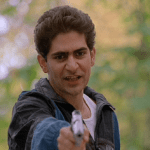 Movies and TV
Movies and TV  Movies and TV
Movies and TV  History
History 10 Momentous Events That Also Occurred on July 4th
 Animals
Animals 10 Times Desperate Animals Asked People for Help… and Got It
 Movies and TV
Movies and TV 10 Movie Flops That Found Their Way to Cult Classic Status
 History
History 10 Things You Never Knew About Presidential First Ladies
 Movies and TV
Movies and TV 10 Zombie Movies That Will Actually Terrify You
 Humans
Humans 10 Times Scientists Were Absolutely Sure… and Absolutely Wrong
 Our World
Our World 10 Pivotal Moments for Life on Earth
 Movies and TV
Movies and TV 10 Most Realistic Medical TV Shows of All Time
 Creepy
Creepy 10 Eerie & Mysterious Ghosts of the Pacific Coast
 Movies and TV
Movies and TV 10 Music Biopics That Actually Got It Right
 History
History 10 Momentous Events That Also Occurred on July 4th
 Animals
Animals 10 Times Desperate Animals Asked People for Help… and Got It
Who's Behind Listverse?

Jamie Frater
Head Editor
Jamie founded Listverse due to an insatiable desire to share fascinating, obscure, and bizarre facts. He has been a guest speaker on numerous national radio and television stations and is a five time published author.
More About Us Movies and TV
Movies and TV 10 Movie Flops That Found Their Way to Cult Classic Status
 History
History 10 Things You Never Knew About Presidential First Ladies
 Movies and TV
Movies and TV 10 Zombie Movies That Will Actually Terrify You
 Humans
Humans 10 Times Scientists Were Absolutely Sure… and Absolutely Wrong
 Our World
Our World 10 Pivotal Moments for Life on Earth
 Movies and TV
Movies and TV 10 Most Realistic Medical TV Shows of All Time
 Creepy
Creepy 10 Eerie & Mysterious Ghosts of the Pacific Coast
10 Directors Who Made Surprising Movie Mood Swings
Many filmmakers develop a brand. Audiences see a director’s name and know to expect a certain type of entertainment experience. When each movie master below leaped to something strikingly different, the result could be an artistic and commercial success or an equally splashy failure.
Related: Top 10 Most Bizarre Movie Casting Ideas
10 Steven Spielberg
Twenty-eight-year-old Steven Spielberg practically invented the summer blockbuster when Jaws (1975), his second feature-length film, more than doubled the gross of its nearest competition. From there, he would amass an unrivaled string of action and CGI-powered hits, including Raiders of the Lost Ark (1981) and its Indiana Jones sequels, E.T. the Extra-Terrestrial (1982), and Jurassic Park (1993). Later, he expanded into ambitious historical dramas such as Amistad (1997), War Horse (2011), and Lincoln (2012), earning more than twenty Oscar nominations for Best Director and/or Best Picture, with wins for Schindler’s List (1993) and Saving Private Ryan (1998).
After tackling mysteries of the universe in Close Encounters of the Third Kind (1977), Spielberg veered hard off course with 1941 (1979), declared on its poster to be “A Comedy Spectacular!” This over-the-top romp had no shortage of comic talent, with a screenplay by Robert Zemeckis (who would later create the Back to the Future trilogy) and featuring John Belushi, Dan Aykroyd, Ned Beatty, and John Candy.
Their characters, fueled by paranoia in coastal California following the attack on Pearl Harbor, proceed to destroy a dance hall, a giant Ferris wheel, and almost everything else in sight. In another change for Spielberg, box office receipts crashed harder than Belushi’s errant fighter plane, and he has not directed another comedy to date.[1]
9 Brian De Palma
Brian De Palma toiled primarily as an indie filmmaker for more than a decade before breaking into the big time with Carrie (1976). Within a few years, promotional material for Dressed to Kill (1980) billed him as “Master of the Macabre.” Scarface (1983), Body Double (1984), The Untouchables (1987), and Carlito’s Way (1993) cemented his reputation for dramas that were often suspenseful, violent, steamy, or all of the above, with A-list stars like Al Pacino, Michael Caine, Kevin Costner, and Sean Connery.
But in De Palma’s first experience with a studio production, he directed the unlikely pair of Tom Smothers and Orson Welles in the off-beat comedy Get to Know Your Rabbit (1972). Smothers (minus brother Dick) made his big-screen debut as a man who walks away from an unfulfilling office job to pursue his dream of becoming a tap-dancing magician. He is tutored by Welles, who once showed off his real-life magic skills by levitating Lucy Ricardo on an episode of I Love Lucy (1956).
Warner Bros. hated everything De Palma did, fired him, reshot scenes, and recut the movie. Still unhappy, the studio shelved the result for a year, then pulled it from theaters after only a few weeks of limited release. De Palma did not work with another major studio until The Bonfire of the Vanities, which also flopped.[2]
8 Blake Edwards
Not surprisingly, Blake Edwards began in films by playing for laughs in the easily forgettable Bring Your Smile Along (1955). He achieved a significant upgrade with Operation Petticoat (1959), starring Cary Grant, before leaving an indelible mark with The Pink Panther (1963) and its early sequels. A touch of that slapstick made its way into the more sophisticated humor of 10 (1979) and Victor/Victoria (1982), both featuring his wife, Julie Andrews. The screenplay of the latter brought Edwards his lone Oscar nomination.
In contrast, just before launching the Pink Panther franchise, Edwards directed two critically acclaimed dramas, the poignant Breakfast at Tiffany’s (1961) and Days of Wine and Roses (1962), about a marriage destroyed by alcoholism. One of his early collaborators would go on to make a literally horrifying genre switch.
William Peter Blatty, the screenwriter for A Shot in the Dark (1964), the second—and some would say funniest—adventure of Inspector Clousseau, would later pen the The Exorcist. His film adaptation produced the top box office hit of 1973 and brought Blatty his only Oscar win.[3]
7 Martin Scorsese
Martin Scorsese is often associated with Robert De Niro or Leonardo DiCaprio playing intense males doing violent and/or immoral things in films such as Raging Bull (1980), Goodfellas (1990), Gangs of New York (2002), The Wolf of Wall Street (2013), and most recently, Killers of the Flower Moon (2023). These tough-guy films have earned Scorsese fourteen Oscar nominations, with a Best Director win for The Departed (2006).
However, in between Mean Streets (1973) and Taxi Driver (1976), Scorsese filmed a low-key love story that became a feminist touchstone. Alice Doesn’t Live Here Anymore (1974) starred Ellen Burstyn as a recently widowed mother chasing her own dreams. After her Oscar-nominated performance in The Exorcist, Warner Bros. gave Burstyn creative control over her next project.
Eager to work with an up-and-coming director, she interviewed Scorsese. Out of concern that he had primarily worked with men, she asked him what he knew about women, and he replied, “Nothing, but I’d like to learn.” Scorsese must have been a quick study because their movie brought Burstyn her third of six Oscar nods and only win, as well as a nomination for Diane Ladd in a supporting role.[4]
6 Sidney Lumet
After years of TV work, Sidney Lumet’s jump to the big screen brought his first of four Oscar nominations as Best Director for the courtroom drama Twelve Angry Men (1957). He followed with other hard-hitting stories in Fail Safe (1964), Serpico (1973), Dog Day Afternoon (1975), and The Verdict (1982).
This track record of gritty subject matter made Lumet a surprising choice to helm The Wiz (1978), based on the smash Broadway musical. The screen version starred Diana Ross as Dorothy (presented as a Harlem kindergarten teacher to fit the thirty-four-year-old star), Michael Jackson as the Scarecrow, and Richard Pryor as The Wiz. Despite its award-winning theatrical pedigree and an all-star cast, the film tanked, as did Lumet’s marriage to the daughter of Lena Horne, who appeared as Glinda the Good.[5]
5 Stanley Kubrick
Stanley Kubrick made movies of epic proportions, whether directing the anti-war drama (1957), the anti-war satire Dr. Strangelove or: How I Learned to Stop Worrying and Love the Bomb (1964), the sci-fi extravaganza 2001: A Space Odyssey (1968), or the equally extravagant A Clockwork Orange (1971). He also helped crush the last of the House Un-American Activities Committee’s influence in Hollywood by insisting that Spartacus (1960) carry the name of previously blacklisted screenwriter Dalton Trumbo.
No stranger to controversy, Kubrick defied social conventions of a radically different kind with Lolita (1962), based on Vladimir Nabakov’s novel about a middle-aged man who becomes infatuated with his landlady’s twelve-year-old daughter (changed for the movie to age fourteen—no better). Years later, Kubrick stated he probably would not have made the film if he had fully appreciated the story’s moral implications and the difficulty he would encounter with censorship issues.
These should have been no surprise, given that only a few years earlier, the book had been banned as obscene in several countries, even France. Though officially unrated, the film was advertised as “for persons over 18 years of age.” Its star, Sue Lyon, did not attend the New York premiere because, at sixteen, she was still too young to see it.[6]
4 Otto Preminger
During a career that began with the advent of talkies, Otto Preminger tackled a range of heavy subjects, including heroin addiction (The Man with the Golden Arm, 1955), criminal justice (Anatomy of a Murder, 1959), the founding of Israel (Exodus, 1960), and political intrigue (Advise & Consent, 1962). He received Oscar nominations for the dramas Laura (1944) and The Cardinal (1963).
After Preminger’s decades of serious films, the release of Skidoo (1968) might have given audiences good cause to ask: What was he smoking? The reality was not far off. Preminger’s son’s account of being a Greenwich Village hippie inspired the director’s own experimentation with LSD, an experience he hoped to re-create in this psychedelic comedy about gangster rivalries.
Another question would be how Preminger managed to bring on board mainstream names like Jackie Gleason, Frankie Avalon, Peter Lawford, George Raft, Cesar Romero, Mickey Rooney, and Carol Channing—here, singing the title song and cavorting in underwear and stockings only a few years removed from her Tony award for Hello, Dolly!On the plus side, this not-long but certainly strange trip provides a rare opportunity to see Groucho Marx in living color, greasepaint mustache and all, as he plays the mob kingpin at the center of what might charitably be called the plot.[7]
3 Alfred Hitchcock
The name Hitchcock brings to mind tales of suspense and cold-blooded killers, including The Man Who Knew Too Much (1934, remade in 1956), The Lady Vanishes (1938), Strangers on a Train (1951), Dial M for Murder (1954), Vertigo (1958), and Psycho (1960). But his film catalog also includes a romantic black comedy with a happy ending, The Trouble with Harry (1955), acknowledged in its promotion as “The unexpected from Hitchcock!”
The title character is a dead body discovered in a rural field, his “trouble” being that confusion causes him to be repeatedly buried and dug up. Hitchcock’s casting decisions match his change in tone. The actors playing townspeople who fear they might be responsible for Harry’s death include Edmund Gwenn, best known as Kris Kringle in Miracle on 34th Street (1947), and screen newcomer Shirley MacLaine, a perky brunette instead of a sultry blonde like Grace Kelly, who starred in Hitchcock’s three previous thrillers.[8]
2 Billy Wilder
Throughout almost half a century of filmmaking, Billy Wilder changed gears almost every time he stepped onto a sound stage, directing movies that rank among the best in multiple genres: comedy (The Seven Year Itch, 1955, and Some Like It Hot, 1959), drama (The Lost Weekend, 1945, Stalag 17, 1953, and Witness for the Prosecution, 1957), and film noir (Double Indemnity, 1944, and Sunset Blvd., 1950). Whether working for laughs or tension, Wilder crafted timeless performances by leading ladies as different as Greta Garbo, Barbara Stanwyck, and Marilyn Monroe. He even made audiences believe that Audrey Hepburn would choose Humphrey Bogart over William Holden in Sabrina (1954).
Although Wilder spoke no English when he fled Europe in 1933 with the rise of Hitler, he was soon writing his own films. He shared an Oscar nomination for the romantic banter of the political comedy Ninotchka (1939), the first of a dozen he would receive for scripts, whether funny or dark. As a director, he racked up eight Oscar nods and two wins, including for The Apartment (1960), a cynical yet humorously touching examination of corporate ambition and marital infidelity bested by true love that spans genres all by itself.[9]
1 John Ford
Born John Martin Feeney to Irish immigrant parents, Ford is best remembered for directing classic westerns such as Stagecoach (1939), which took John Wayne out of low-budget cowboy flicks and made him a star. Ford put Wayne on horseback again and again, notably in Fort Apache (1948), She Wore a Yellow Ribbon (1949), The Searchers (1956), and The Man Who Shot Liberty Valance (1962).
Yet Ford received his greatest critical acclaim for films that traded the vast landscapes of Monument Valley for the intimacy of the human heart. He won his first Academy Award for directing The Informer (1935), about a poor Irishman in the 1920s who turns in an IRA rebel to secure a reward from British authorities.
He later took home back-to-back Oscars for The Grapes of Wrath (1940) and How Green Was My Valley (1941), a sensitive look at hardship in a Welsh mining town. Ford returned to his roots and won his final Oscar for The Quiet Man (1952), again casting Wayne, but this time as an Irish-American boxer who retreats to his birthplace after killing an opponent in the ring. This film allowed Ford to knit together his creative strands.[10]








